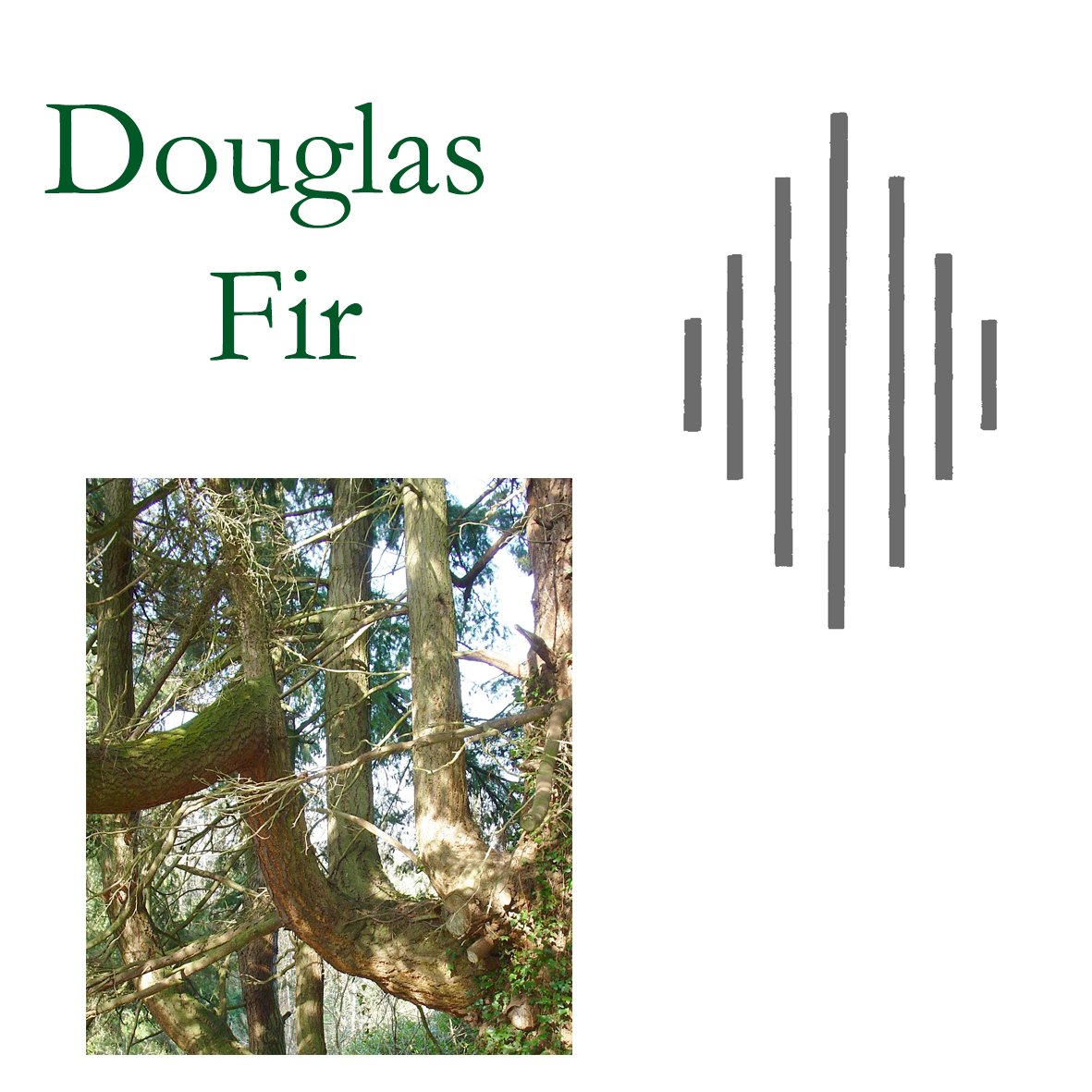Douglas Fir ( Pseudotsuga menziesii)
Douglas fir is a magnificent tree, one of the largest in the world. It is native to North America and makes up a significant proportion of the temperate rainforest of the Pacific North-West coast. It can grow to over 300ft (100m.) in America and to 180ft (55m.) in Britain, though as a commercial forestry tree it is rarely left to grow more that 100 ft (40m.) because of the sheer difficulty in moving the huge trunks.
Douglas fir is named after David Douglas who sent seed to the Horticultural Society in 1827. The Latin name remembers Archibald Menzies who first found the tree and sent a sample of foliage to Kew in 1793. The original site where seed was collected happened to be ideal for growth in Britain, especially around Perth in Scotland, from where Douglas originated. Many of the first trees are still growing well. Stands of Douglas fir are often left in forests as shelter belt for less robust species.
Douglas fir has a corded, corky bark of dark grey or purple. Its foliage is held on large down-swept branches and is a dense covering of rich dark green that deeply shades the ground underneath. The leaves have a sweet, fruity scent. Cones of Douglas fir are easily identified by the papery forked tongue emerging from the base of each scale. Male flowers are small yellow buds along the end of branches, whilst female flowers can be found at the end of branches as red-orange tassels.
The Essence:
Keywords: “Standing alone”; relatedness; finding one’s place; room to expand; need to be a part of, need to be apart from; parts of a whole; spontaneous energy; freedom to be oneself; living life to the full; balancing the flow; connectivity and relationship; energy to grow; for those who feel they stand out in a crowd, who feel a sense of difference that inhibits the way they wish to be.
The primary energy of Douglas fir concerns itself with finding space to be and to act as oneself. All aspects of this relationship with the world outside, and to finding one’s place in the world, are brought into a better balance with this tree’s help. It gives the dynamism for spontaneous activity, which is nonetheless appropriate and balanced. Energy to grow and space to act are easier to find.
The Triple Warmer meridian is concerned with the maintenance of the body’s own internal systems, ensuring a correct working relationship between organs. When imbalance is found in this meridian Douglas fir will naturally help to restore calm equilibrium. This will be particularly pertinent when there is stress around issues to do with being alone or being with others. Where there is a need to feel part of a group, of belonging and being valued, as serving a useful function in a group but where there is also a need to be apart from the pressures and commitments of complex relationships, this tree essence will help to resolve the opposing tensions.
Extra energy is given to the desire to live life fully and openly but not to become reckless, nor to retreat from fear of danger. This essence can bring a feeling of belonging that encourages the openness of the heart centre. The sense of supported freedom relies on a good connection to the energies of other people. Being too dependent on how others feel, relying on their obvious encouragement before any activity is even contemplated, is indicative of imbalance and a lack of life force. On the other hand, Douglas fir will bring a more appropriate perspective to those people who disregard totally the needs of others or who fail to reciprocate with the normal sharing of energy. In this way Douglas fir helps to maintain a correct flow of energy relationship between the self and others.
At the most refined level this can manifest as an open appreciation of all things, an understanding that every life and every object has its own inherent value in the context of the whole. Douglas fir brings us the clarity of awareness to recognise this connection between all individual selves. It helps to cleanse and purify those separating and limiting belief patterns that prevent the true expansion of self-awareness. Ultimately realising that the sense of self, of unique being-ness, is not just a property of the sentient, living individual, but is simply a reflection, at the finite level of perception of an unlimited all-encompassing nature, a characteristic of every aspect of existence. “I am” is no longer just a barrier that exists to prevent the victory of “I am not”. “I am” simply becomes the uniting universal consciousness reflected in every aspect of that creation. “I am” is simply the “I am” with this particular viewpoint, from this body, at this time. Everything else’s “I am” has the same validity and the same significance – it is the same substratum of awareness, the same foundation of being. In this sense there are no individuals, only points of view.
Signature:
The size, mass and solidity of the tree. Its ability to protect its neighbours. Its great height reflects the breadth of perspective. Its deep green foliage, the Heart centre, focus on relationship with the world.

